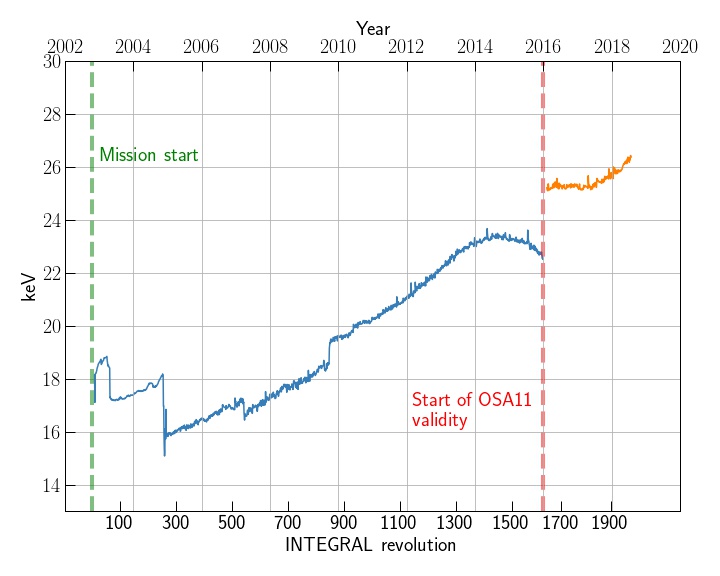



Next: ip_ev_shadow_build
Up: ibis_binning
Previous: ibis_binning
ii_shadow_build
The executable ii_shadow_build creates shadowgrams of ISGRI
events in the given time (Tbin) and energy (Ebin) ranges. For every
shadowgram a corresponding efficiency shadowgram is created. For
pixels active during the revolution (switch status ON), efficiency
falls into two components and is null for the others: the first factor
takes into account the dead time of the corresponding module MDU; the
second factor reflects the efficiency energy dependence, extracted
from ISGR-EFFC-MOD structure.
The position of the characteristic low threshold value is evolving
with time as can be seen in the Fig. ![[*]](crossref.png) , with the
ISGRI efficiency being lower than 50% below this energy. As an
example, for revolutions later than Rev.1000, energies below
22
keV should be ignored, and after Rev. 1600 it is not possible to use
ISGRI data below
30 keV for accurate spectral fitting.
, with the
ISGRI efficiency being lower than 50% below this energy. As an
example, for revolutions later than Rev.1000, energies below
22
keV should be ignored, and after Rev. 1600 it is not possible to use
ISGRI data below
30 keV for accurate spectral fitting.
Figure:
ISGRI low threshold position as function of INTEGRAL revolution number. Notice that
this is the lowest limit of detectable photons, but individual pixels
might have a higher low threshold. The recommended energy ranges
to analyze spectra are given in Section ![[*]](crossref.png) , ISGRI known issues.
, ISGRI known issues.
|
Together with the NOMEX correction, applied in ii_skyimage, ii_spectra_extract and ii_lc_extract, the efficiency energy dependency model attempts to recover the
equivalent ``true'' spectrum, independent of the time in the mission and source position in the FoV.
It should be noted that interpretation of the count rates derived from the efficiency-corrected detector count rates, should be done with caution, owing to several limitations:
- since the true efficiency is affected on the efficiency of the multiple event rejection in a presence of evolving threshold in IBIS (ISGRI, ISGRI-PICsIT, and ISGRI-Veto) which depend on the source spectrum, unknown at this stage of the pipeline. A completely accurate modeling of this effect is not implemented in OSA at this point.
- different non-diagonal components are affected in a unequal ways by the NOMEX and detector efficiencies. Which is why source count rates in fixed energy ranges should be used with the instrument response generated for each specific source in the FoV. This effect is approximately corrected at a later stage, but a single time-evolving response is used.
- substantial degradation of the energy resolution implies an irreducible mixing of the source counts in different energy ranges. In principle, this effect is corrected with the evolving response, but it causes a particular challenge for a direct interpretation of the source count rates.
- OSA11 and OSA10.2 use different algorithms to reconstruct the energy of incoming photons, which result in a different conversion of the electric signal in the detector to photon energy. The position
of the low threshold of Fig.
![[*]](crossref.png) is also affected.
is also affected.
This executable also applies two different noisy pixel detection techniques. The first one is time-based; it discriminates every pixel for which the scientific SELECT_FLAG equals one (even only once over all the
Science Window events). Note: this flag was filled by the executable ibis_isgr_evts_flag. The second method is
spectral-based; it discriminates pixels by estimating their spectral deviation from the average ISGRI spectrum.
This spectral method can be switched ON/OFF by parameter NoisyDetFlag.
Table:
ii_shadow_build parameters included into the main script.
|
|
|
|
|
|
Name |
Name |
Type |
Description |
|
(in the main script) |
(executable) |
|
|
|
IBIS_II_ChanNum |
isgri_e_num |
integer |
Number of energy intervals for ISGRI.
possible values: 1 - 10
default: 7 |
|
IBIS_II_E_band_min |
isgri_e_min |
string |
List of lower energy boundaries (keV).
default: "15 40 100 200 400 700 1200" |
|
IBIS_II_E_band_max |
isgri_e_max |
string |
List of upper energy boundaries (keV).
default: "40 100 200 400 700 1200 2500" |
|
IBIS_min_rise |
isgri_min_rise |
integer |
Minimum rise-time.
default: 16 |
|
IBIS_max_rise |
isgri_max_rise |
integer |
Maximum rise-time.
default: 116 |
| IBIS_NoisyDetMethod |
NoisyDetFlag |
integer |
Defines the way to deal with noisy pixels
possible values: 0 Time-based noisy detection;
1 Time-based + Spectral-based method.
default: 1 |
|
|
|
|




Next: ip_ev_shadow_build
Up: ibis_binning
Previous: ibis_binning
2020-09-18
![[*]](crossref.png) , with the
ISGRI efficiency being lower than 50% below this energy. As an
example, for revolutions later than Rev.1000, energies below
22
keV should be ignored, and after Rev. 1600 it is not possible to use
ISGRI data below
30 keV for accurate spectral fitting.
, with the
ISGRI efficiency being lower than 50% below this energy. As an
example, for revolutions later than Rev.1000, energies below
22
keV should be ignored, and after Rev. 1600 it is not possible to use
ISGRI data below
30 keV for accurate spectral fitting.
